What Is Shadow Pressing?
For the purposes of this tactical analysis, shadow pressing is defined as the moment a player whose team is in possession follows closely behind an opposing player who is pressing the ball.
The aim of the shadow press, during the build-up phase, is for the shadow player to exploit the space behind the pressing striker.
The assumption is that by being so close to the striker, a midfield player will not jump to press them.
This concept was deployed consistently by Roberto De Zerbi’s Brighton in the Premier League.
This tactical theory analyses the principles involved in shadow pressing and provides examples from the side De Zerbi is now in charge of, Ligue 1’s Olympique Marseille.
This shadow press analysis focuses on how ‘6’s can use this tactic to progress the ball from their centre-backs to their attacking players in the build-up phase.
The analysis will show how ‘6’s can use the space behind the presser to either angle off and receive directly from the player being pressed or use a third-player combination.
This tactical analysis will provide in-game examples of how this tactic is being deployed to help describe this tactical theory.
Also included are training session ideas which improve players in this aspect and aid coaches in implementing shadow press tactics.
Using Shadow Pressing To Create Angles
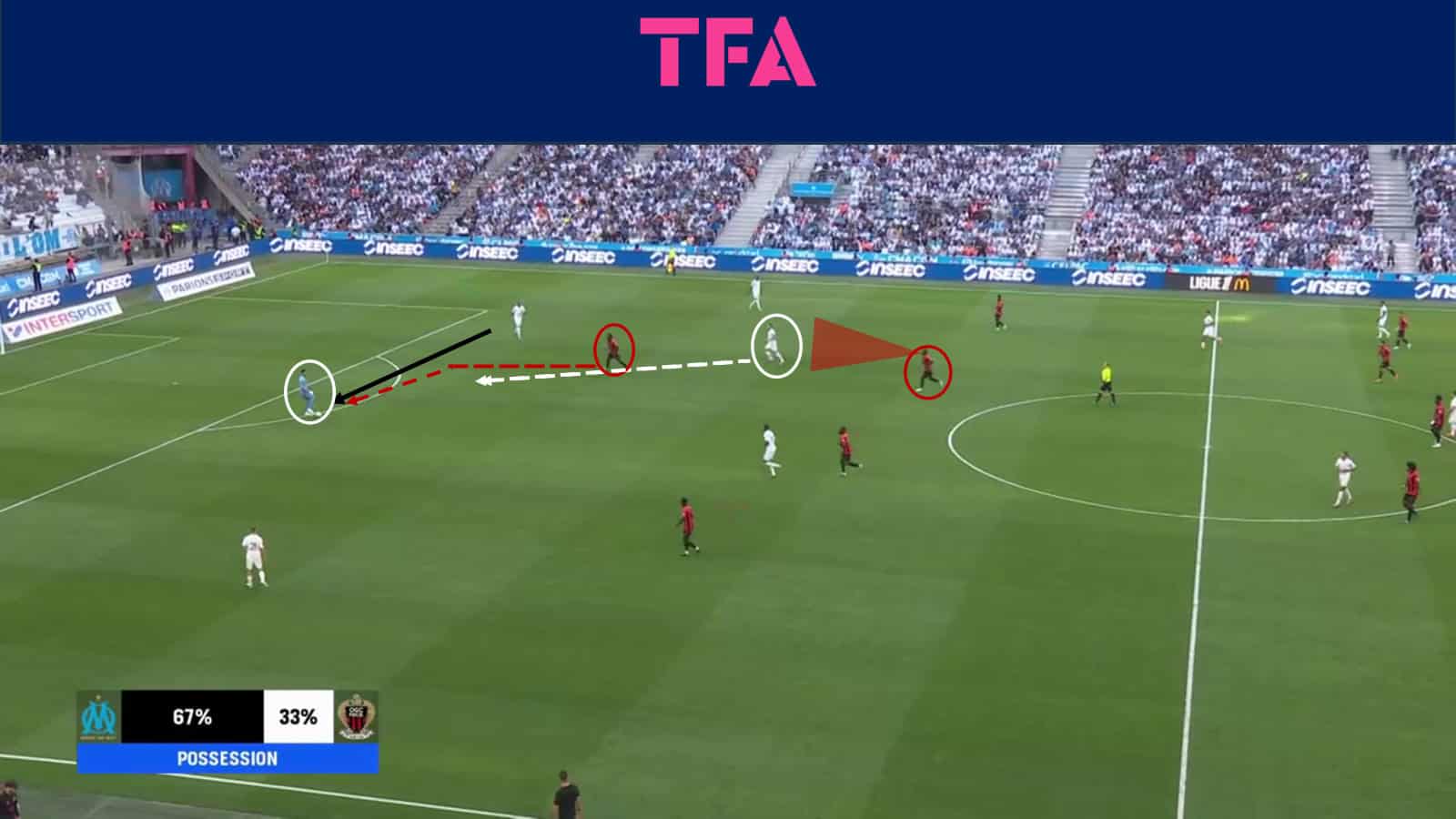
This example, from Marseille’s recent match against Nice, shows their defensive midfielder shadowing a pressing striker’s movement with the aim of opening up space to receive directly from the player being pressed.
In this scenario, the one striker is making a looping run to close down the goalkeeper, who has just received from his left centre-back.
The opposition’s central midfielder (circled) moves closer to the centre circle and is about to jump to the Marseille defensive midfielder.
As the defensive midfielder tracks the striker’s press, the central midfielder stops trying to catch him.
Had the midfielder continued to track his opposite number, a big gap would have been created behind Nice’s midfield line.
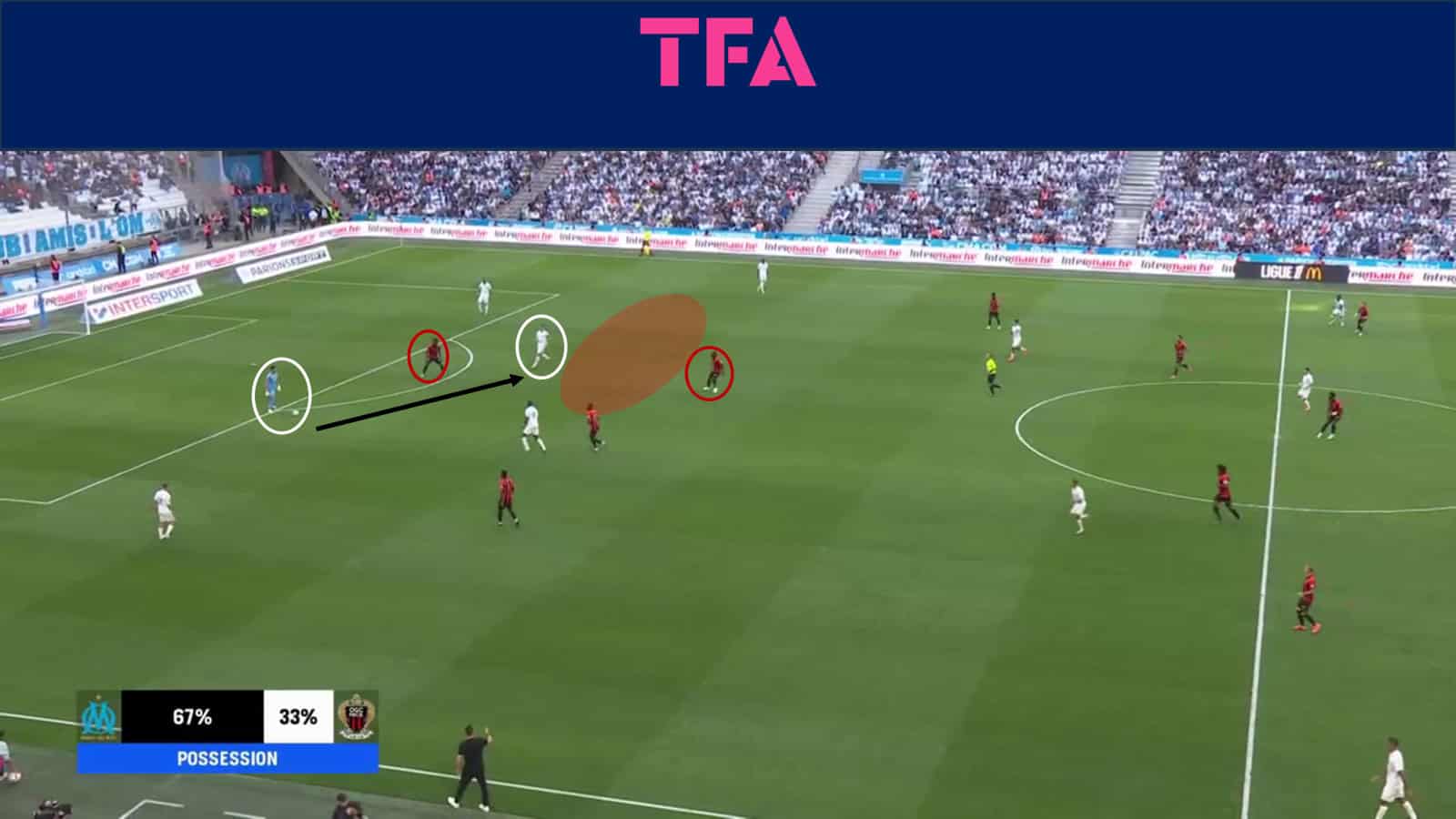
Now, with space ahead of him and the closest opposition player (the striker) unaware of his positioning, the ‘6’ is able to turn side-on with enough space ahead of him to pass or dribble forward.
In most cases, the ‘6’ would have to make a quick movement on either side of the pressing player before that player got too close to the ball to create an angle for receiving.
In this example, however, the final movement required from the ‘6’ to show from the ball was minimal.
By looping his pressing run in an attempt to cut off half the pitch, the striker did a lot of the work for the midfielder.
A slight movement to his left was enough for the ‘6’ to create a clear passing lane.
Third Player Combination
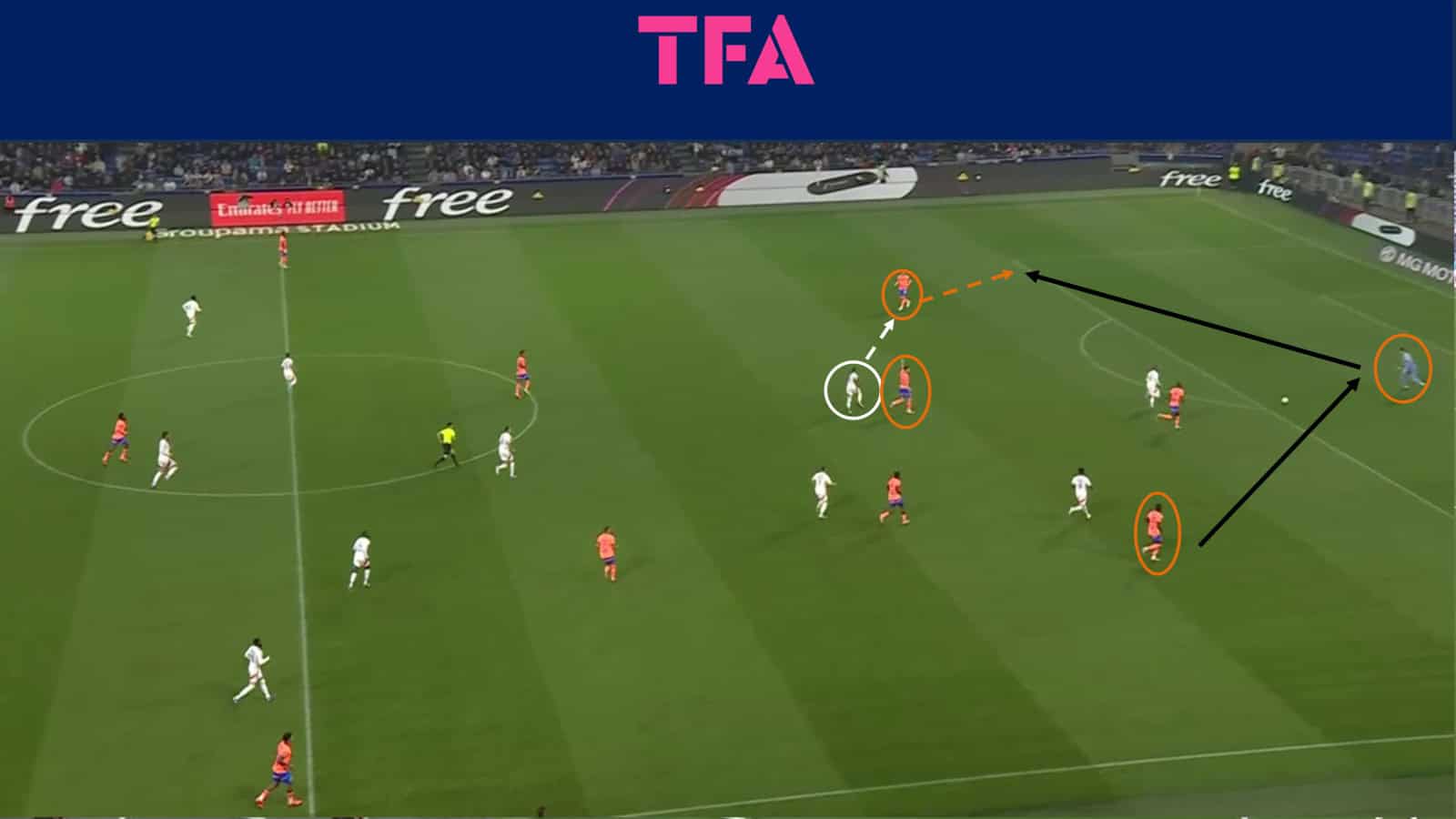
The above image shows Marseilles (in orange) in their recent match against Lyon, switching the ball from their left centre-back to right centre-back via the goalkeeper.
As the ball was travelling to the goalkeeper, the right centre-back backtracked to open up and receive the next pass from the goalkeeper.
The Lyon forward, who was marking the ‘6’, read this pass and began to jump to press the right centre-back before the ball was played.
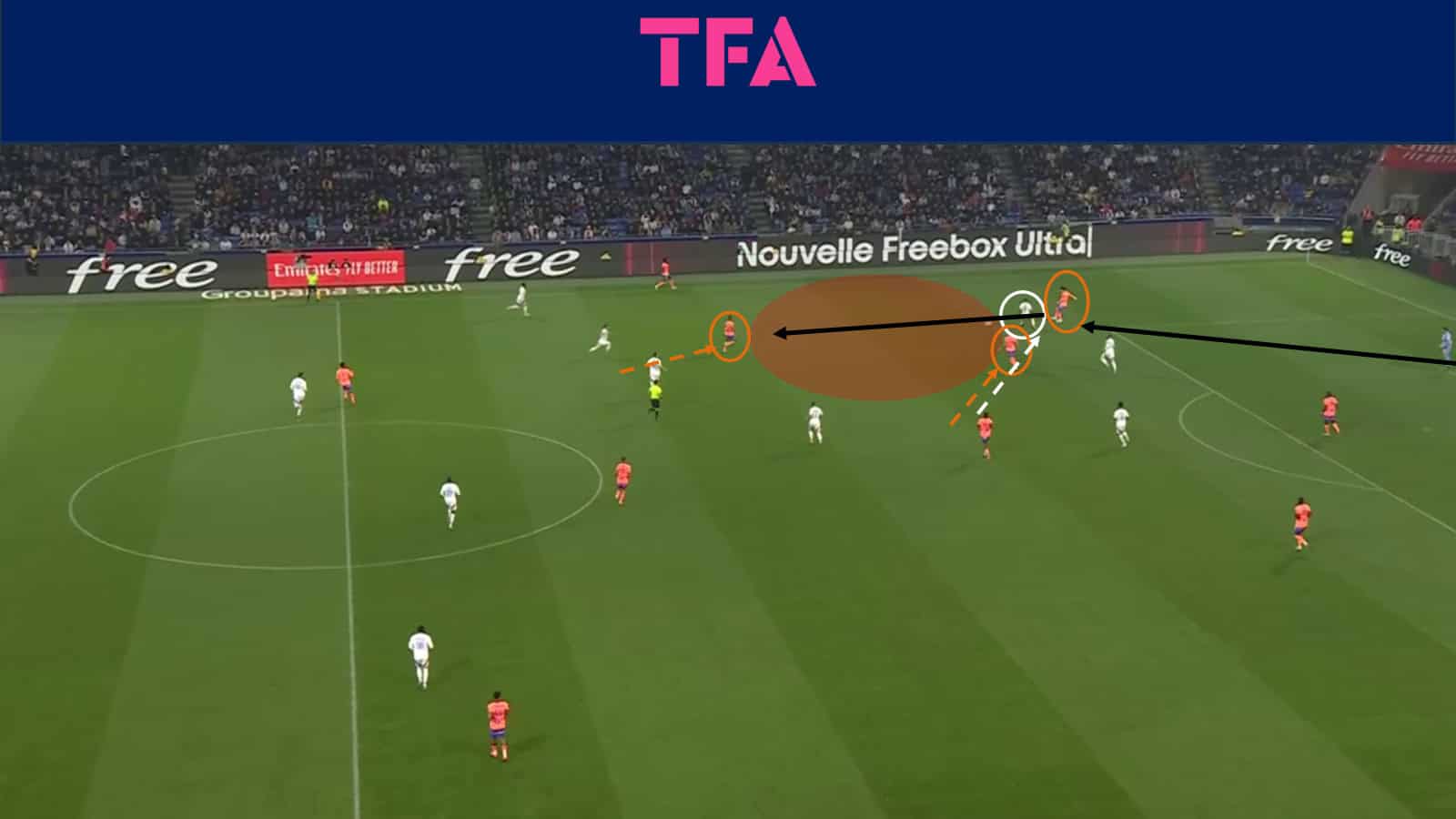
As the forward pressed the centre back, the ‘6’ closely shadowed him as he ran towards the player with the ball.
The centre-back then played down the outside of the pressing forward into a central midfielder who made a sharp movement towards the ball.
The ‘6’ is now positioned just meters from the pressing forward.
By being deep and so close to an opposition player, the Lyon midfielders do not want to jump with him.
Not only would this have meant them having to sprint a considerable distance, with no guarantee they would catch the moving ‘6’, but they would have also left a large area of the pitch empty.
Had the ‘6’ remained stationary when his marker left him to press the ball, Lyon could have far more easily had a player step up to him.
As the ball gets played forward, the ‘6’ turns to face up the pitch and now has an abundance of space ahead of him.
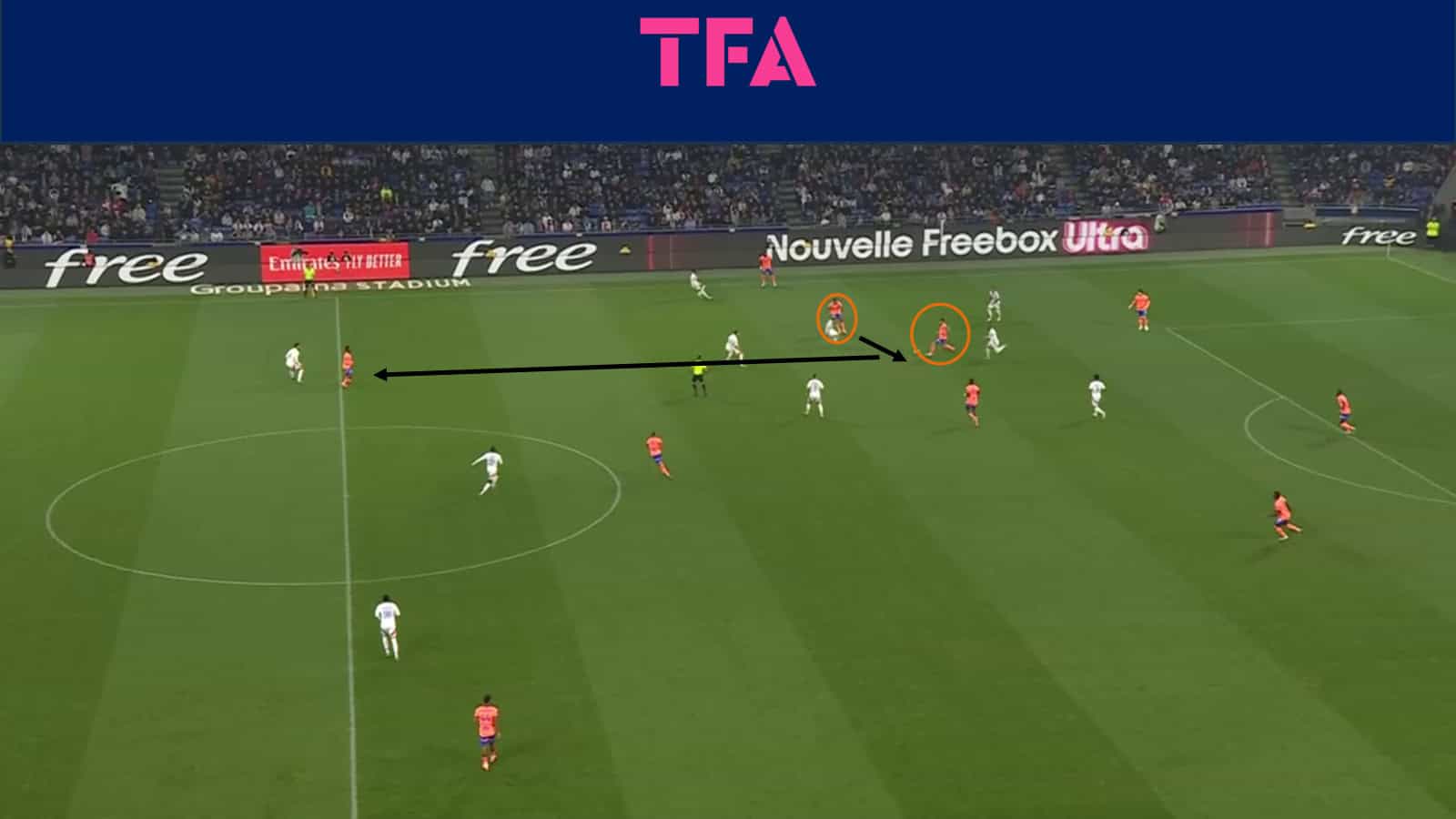
The central midfielder then lays the ball back to the forward-facing ‘6’.
The weighted pass allows him to progress the ball into his forward with his next touch.
Whilst he now has some pressure from behind, he has more than enough time to play a first-time pass.
During this phase, the ball is kept secure at all times, and every player who touches the ball does so, allowing him to face the way he is going to play.
This has allowed maximal efficiency, with no one having to turn or take extra touches on the ball.
Warm-Up Activity To Practice Shadow Pressing
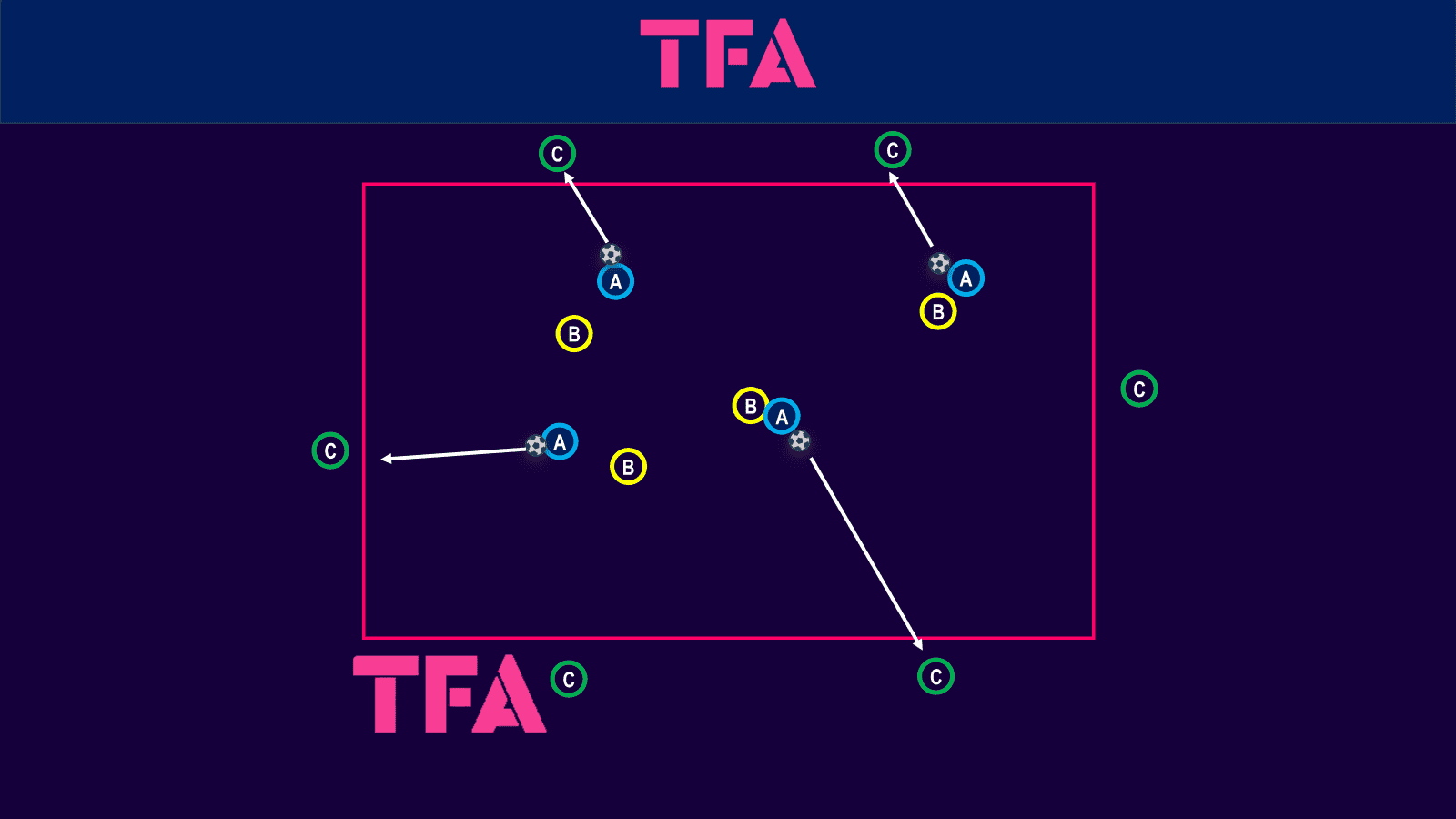
This introductory activity focuses on the movements of the shadow-pressing player and can be included as part of the warm-up.
It is designed to prepare the players both physically and psychologically for the actions that will form the focus of the training session.
This exercise provides the opportunity for many repetitions, embedding the principals involved in shadow pressing and creating many opportunities for coaching points.
The set-up has six players on the outside of a rectangle and eight players in the middle, working in pairs with one ball per pair.
The players will rotate constantly, and the numbers can easily be adapted depending on the number of players working.
The exercise begins with a ball from each pair being passed out to one of the side players.
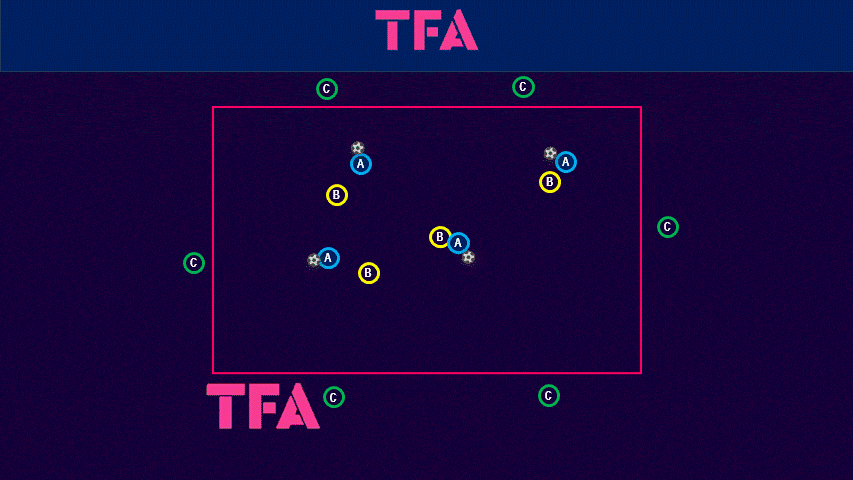
The player who passes the ball to the side then charges at the receiving player to become the “presser”.
The second member of the pair then tracks his pressing movement before opening up and creating an angle to receive from the side player.
With a side-on body shape, the player receiving in the middle plays a bounce pass into the path of the side player who has now left their starting position to burst into the box.
The player who played the bounce pass then replaces the side player.
The now-receiving player takes a touch before finding another player with a firm pass on a different side of the box.
Immediately after playing the pass, this player becomes the “presser,” and the previous pressing player tracks their movements before receiving the next pass.
The distances should be realistic, providing enough time and space for the shadow-pressing action to be completed.
Coaches should emphasize the importance of tracking pressing runs closely to create space behind the pressing player in the middle of the box.
The correct timing of the movement to open up and receive needs to be emphasized.
It must be deep enough to open up space, but an interception becomes likely before the pressing player gets so close to the ball.
Shadow Pressing Rondo
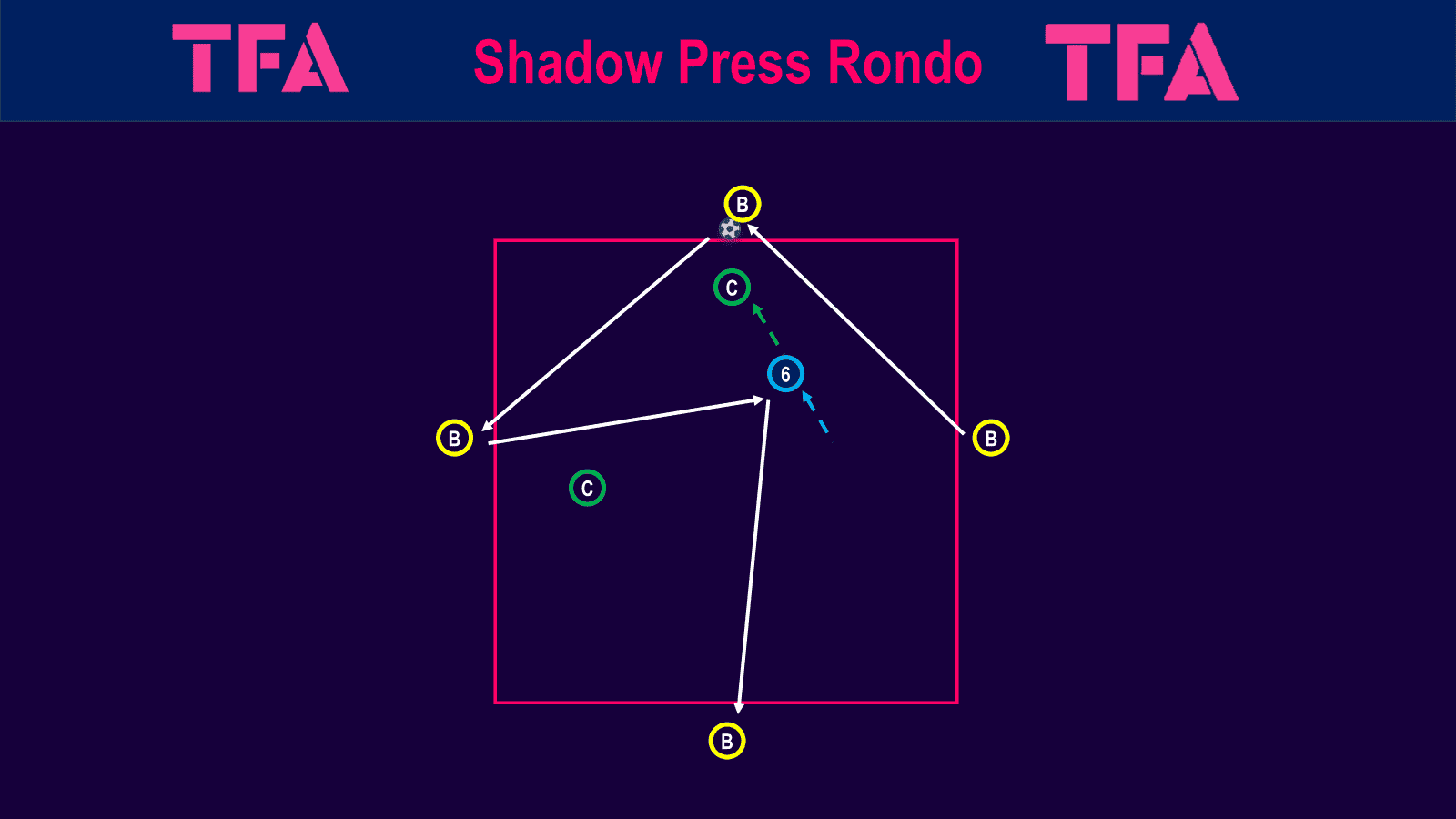
This rondo is designed to work on the movement, awareness and control of the shadow presser playing as a ‘6’.
Four players occupy a side of the box each, with two defending players in the middle and the ‘6’.
The side players and ‘6’ work as one team to keep the ball as long as possible.
The aim is to play around a pressing player, into the ‘6’, and out to the other side.
The coach may wish to increase the size of the rondo box than they would typically use to increase the number of opportunities for the ‘6’ to receive.
To increase the speed of play, a two-touch limit can be introduced, with players who give the ball away joining the defending team.
To encourage the in-possession players to find the ‘6’, a point can be awarded every time the player receives and plays out to a different side player, changing the direction of the ball.
The ‘6’ can be limited to one touch to help embed the desired body orientation and make the ball’s movement as efficient as possible.
This would prevent the player from being able to turn with the ball to compensate for poor body shape.
Shadow Press Pattern of Play
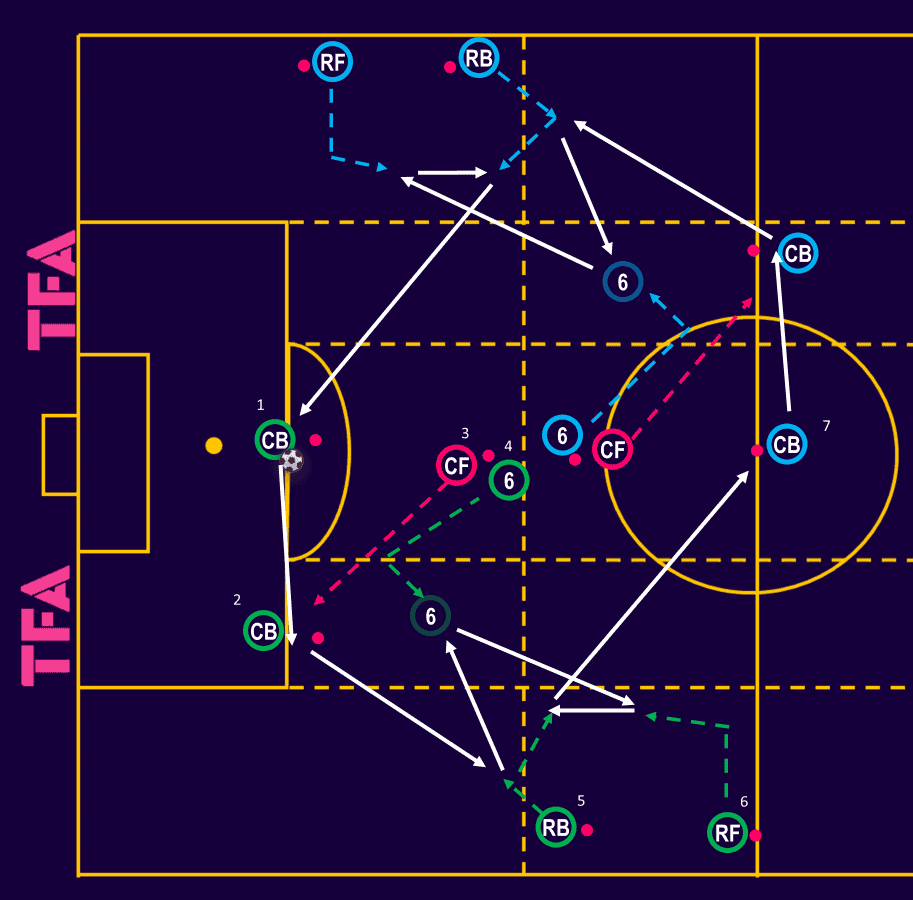
This passing sequence is designed to include pressing players, giving the exercise a “live” press to play around with, providing the drill with an element of realism.
Including a pressing player is particularly useful for this exercise’s aims as it gives the players a moving reference point to play with.
It is also game-like, which allows players to work on the timing and angle of their movements.
The position the player at each station represents is indicated in the image.
The exercise is designed with each player rotating after every pass, with the ball working in a continuous cycle. However, it can easily be adapted so that players remain in their specific positions.
The ball starts with one centre-back who plays a square pass to the right centre-back.
This pass acts as the trigger for the central forward to press.
As the forward presses the ball, the ‘6’ shadows their run closely.
The ball is then played wide, into the right back, before being bounced into the ‘6’ who is now facing forward.
The wide forward moves to receive before bouncing the ball into the path of the right-back, who then plays into the centre-back/forward for the drill to be repeated on the opposite side.
The numbers on the diagram indicate the sequence of the rotation of the players within the drill.
The centre-back who plays the ball wide becomes the pressing player, who then becomes the ‘6’.
The patterns can be amended in various ways to include different reactions from the ‘6’.
For example, the right-sided centre-back can find the ‘6’ directly, and the ‘6’, on the half-turn, can progress the ball to one of the more advanced players.
It is vital that coaches embed the timing and the distance of the tracking run.
The ‘6’ should follow the forward, creating distance between themselves and the theoretical opposition midfielders, but not so close that the forward will be able to react quickly enough to the ‘6’ receiving the ball.
The angling off to receive should be done at the last possible second to give the opposition minimal time to react.
Conclusion
The tactical theory of shadow pressing is a strategy that can allow for the efficient and less risky progression of the ball during the build-up phase.
By closely tracking pressing movements, the ‘6’ can create space between the opposition forwards and midfield to receive in.
The movements can allow the midfielder to receive on the half turn or, with the help of a third-player combination, facing forward.
By working on the timing and technical components involved, coaches can implement this strategy into their own build-up play patterns.

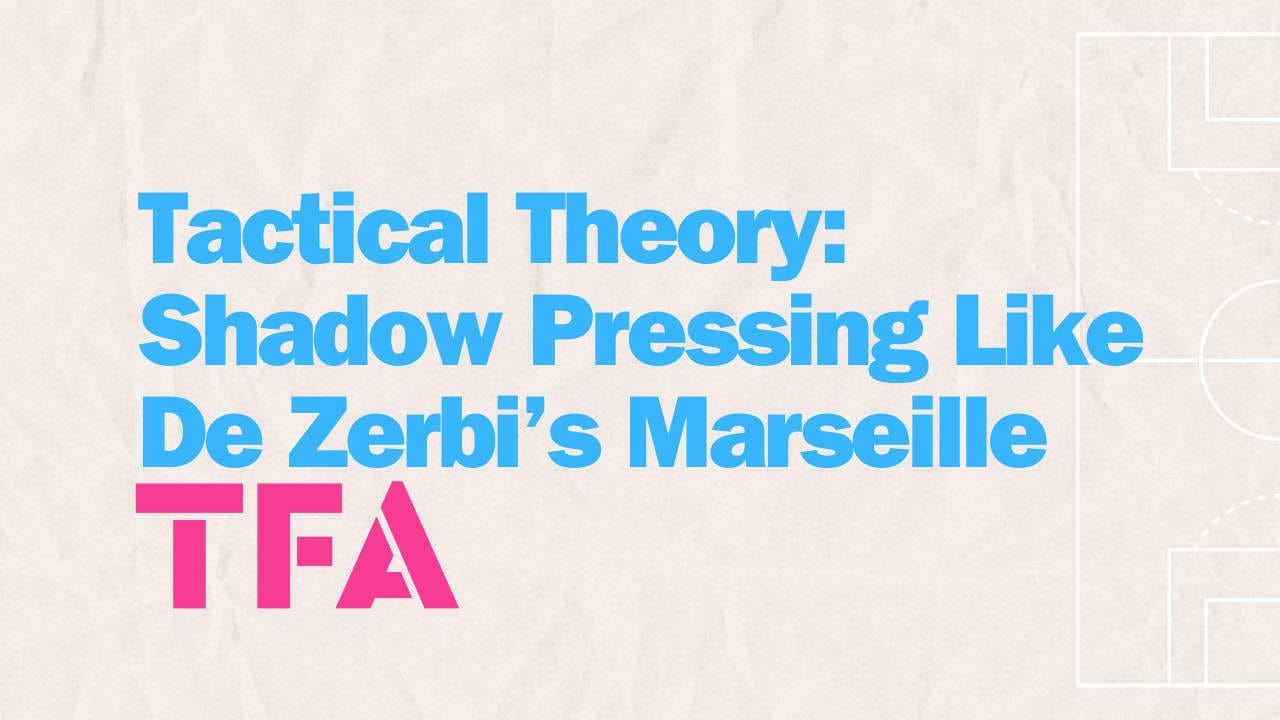




Comments